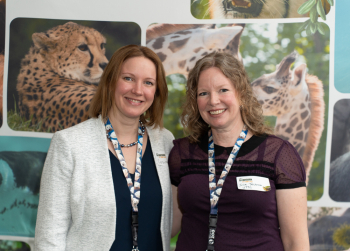When she teaches a course on primate behaviour, Professor Julie Teichroeb arranges passes for her students to visit the Toronto Zoo. It allows them to observe primate behaviour up close and experience first-hand what they learn in class.
Thanks to a new partnership, Teichroeb will soon be able to host multiple classes — and even entire courses — in a new teaching and research facility located at the zoo.
“This opens up so much potential for experiential learning,” says Teichroeb, an expert on primate behaviour whose research focuses on vervet monkeys and the Angolan colobus.
“Our students will be able to get hands-on learning opportunities at the zoo in disciplines such as anthropology, biology, environmental and conservation sciences.”

The partnership is part of the Toronto Zoo’s Community Conservation Centre, a new 2,600 sq. metre (28,000 sq. ft.) facility that includes a new welcome area and public entrance with a multi-purpose event and education spaces. Plans for the facility include research and teaching labs, public classrooms and an otter habitat that will all be visible as guests walk up to the front entrance.
U of T Scarborough will have two dedicated research labs and priority access to the two teaching labs and four classrooms in the new facility.
Dolf DeJong, CEO of the Toronto Zoo, says one of the main goals of the conservation centre is to make science education, particularly conservation science, more accessible to the public.
“Our team does a lot of amazing conservation science and animal reproductive research behind the scenes, so we wanted to make that work more visible. This is going to be something the public can see and experience as they walk up, even before they enter the zoo,” he says.
DeJong points to the Blanding’s turtle head-start program as just one example of the conservation projects the zoo plans to put front and centre in the new facility. He adds the zoo will now be able to host more public education and science engagement opportunities with local elementary and high school students, while the space is also available to community members to book meetings or events.
U of T Scarborough already has deep ties to the zoo, including joint research projects, classroom learning opportunities, student research programs and collaborating on the annual event Science Rendezvous, among others. Partnering on a joint facility is one important way to deepen those ties, says Andrew Arifuzzaman, U of T Scarborough’s chief administration and strategy officer.
“As neighbours and important anchor institutions in Scarborough, we have a long and proud history of working together. This project really formalizes that partnership,” he says.
Arifuzzaman says the emphasis on conservation and sustainability also complements U of T Scarborough’s involvement in EaRTH, a training and innovation hub involving various universities and colleges across the eastern GTA.

A group of faculty members from various departments as well as campus architects at U of T Scarborough collaborated with the zoo and Zeidler Architecture on the design of the research and teaching spaces. The teaching labs were even modeled after the recent renovations to the department of biological sciences teaching labs at U of T Scarborough.
Cosima Porteus, an assistant professor in the department of biological sciences, says the department can use the labs for projects looking at improving animal health and welfare, and preventing biodiversity loss.
“We designed the labs to be flexible so they can accommodate diverse research needs and to easily change to support a variety of research programs,” says Porteus, whose research looks at how aquatic animals interact with and respond to their environment.
“We see this as a partnership that will benefit both institutions in advancing knowledge about both animal and plant health, reproduction and interactions with their environment.”
